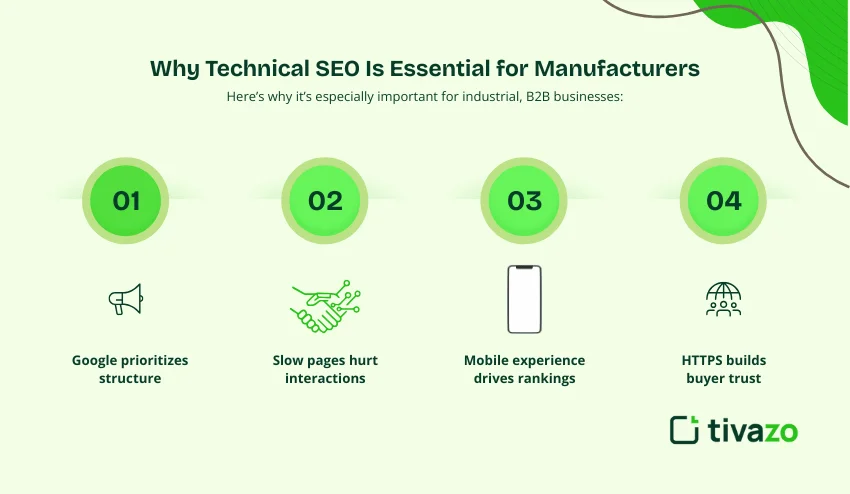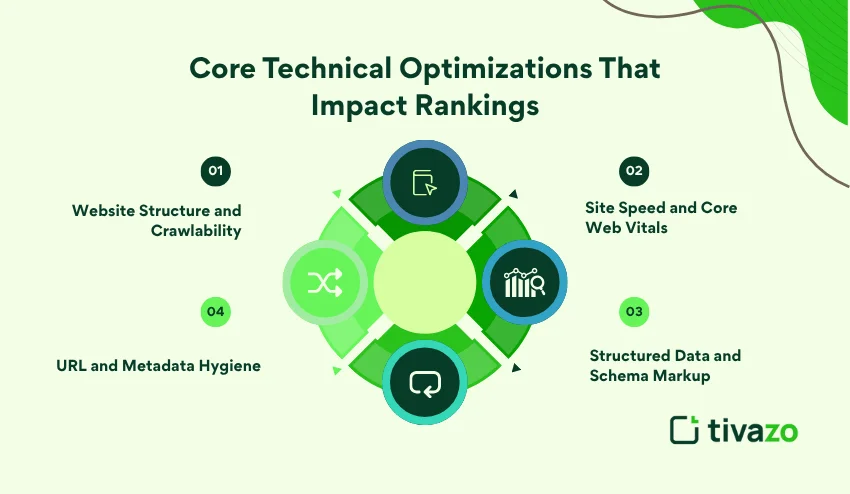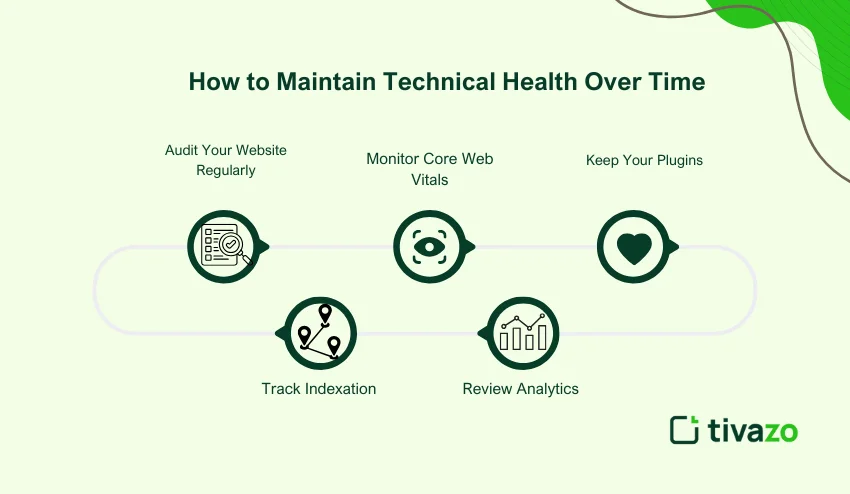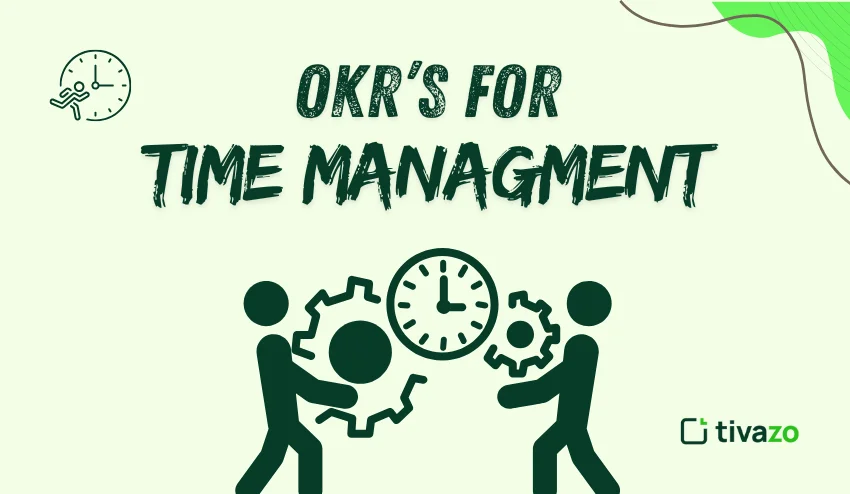Many manufacturers don’t think of SEO outside of keywords, blogs, and links. Those tasks are certainly important; however, they all rest on a singular concern: technical stability. If your website isn’t formatted correctly, takes too long to load, or confuses the search engines, then you could have all the content in the world and still not retain rankings.
Technical SEO is what keeps your site functioning, discoverable, and cohesive. It’s the invisible machine that engages Google to communicate to customers what you sell, how your website is structured, and if your site even deserves to rank.
This is important to manufacturers! Your website probably has hundreds of product pages, spec sheets, and PDFs. Without technical SEO maintenance, you could be at risk of having those valuable pages dropped from search, which can directly reduce your incoming leads!
This guide identifies the technical optimizations that drive SEO for manufacturers, including site speed and structure, and ongoing maintenance for long-term site performance consistency.
Why Technical SEO Is Essential for Manufacturers
Technical SEO ensures that your site is crawlable by the search engine, understandable, and trustworthy. For manufacturers, this technical foundation is what keeps your online presence visible to buyers. Without it, even the best content or marketing efforts typically won’t rank anywhere with search engines or reach the right people.

Here’s why it’s especially important for industrial, B2B businesses:
- Search engines, specifically Google, rely far more on structure than assumptions. An organized site structure allows Google to find and/or index your product pages, your case studies, your service pages, etc. If your site contains a lot of broken links, duplicate content, or snippy URLs, the important pages may never see the (search) light of day.
- An analytic study released by Google in 2024 indicates that any webpage taking longer than three seconds to load is likely to experience both increased bounce rates and decreased interactions. In a manufacturing setting where customer decision-making relies on precision and professionalism, you do not want a slow website triggering fear or creating doubt.
- For good measure in the context of rankings, user experience is now important to any search engine’s algorithms. For example, Google utilizes mobile-first indexing, which means sites are adequately ranked based on their mobile experience first.
- A proper implementation of HTTPS, clean URLs, and structured data provides signals that your site is secure, maintained, and transparent. Trustworthiness is an important aspect that a buyer wants from a credible industrial supplier.
- A technically sound website is easier to maintain, make update, and measure. When you do have new products to add or new markets to penetrate, you’ll rest assured that the overall SEO performance will stay steady when leveraging on-page techniques.
Technical SEO is the base layer work of websites for manufacturers that will keep things running smoothly, loading fast, and is effective at handling complicated data and numerous detailed website content.
Core Technical Optimizations That Impact Rankings
Technical SEO enhances your website to align with what search engines expect to discover ranking and distribute traffic as needed, and if executed properly, helps your best content and product pages be discovered and read. In manufacturing, first-round technical fixes can have a high return because most manufacturers overlook them altogether.

Below are the optimizations that have the strongest impact on visibility and performance
1. Website Structure and Crawlability
Google cannot rank what it cannot discover. A clear and logical site structure assists search engines in discovering and indexing your pages without confusion.
Key actions:
- Have your site organized like a product catalog: home → category → subcategory → product
- Keep important pages within three clicks of home.
- Use internal links to link to additional product or service pages for related products.
- Submit a relevant XML sitemap via Google Search Console.
For large manufacturing sites with hundreds of SKUs or service variations, structure is not only for SEO; it helps buyers and algorithms navigate your content easily.
2. Site Speed and Core Web Vitals
Speed influences both rankings and user interaction and engagement. Manufacturing websites often have large images, specifications, and embedded media, so they can often be slower.
Ways you can improve speed:
- Compress images and save them in WebP.
- Remove any plugins and scripts that are no longer required.
- Use browser caching and enable GZIP or Brotli server compression.
Compress images and save them in WebP.
- Largest Contentful Paint (LCP): Try to get that under 2.5 seconds
- Cumulative Layout Shift (CLS): The CLS should be low.
- First Input Delay (FID): Anything higher, and users are going to start feeling frustrated.

3. Structured Data and Schema Markup
Schema markup is a big help for Google in getting to grips with what you’re saying. And for manufacturers, that means that things like product details, reviews, and company info can show up directly in search results as special little extra bits of info.
Some examples of schemas that are likely to be relevant to a manufacturing site include:
- Product pages that show off details such as name, model number, what it does, price, and whether or not it’s in stock.
- FAQs or how-to guides that help people work things out for themselves.
- Basic business info like address, phone number, and your logo.
Schema does not guarantee higher rankings, but it improves visibility and click-through by making your results more comprehensive.
4. URL and Metadata Hygiene
Although URLs and metadata may seem trivial, they help search engines understand what your web pages are about. Clear and consistent URLs and metadata eliminate indexing issues and improve click-through rates.
Checklist for URLs and Metadata:
- Use short and descriptive URLs (For example, /services/cnc-machining-chicago/). Do not use random numbers, special characters, or duplicate slugs.
- Write unique title tags for each page (60 characters) and meta descriptions (150-160 characters).
- Use your primary keyword naturally in both.
- Include canonical tags to avoid any duplicate content-related issues.
A clean website structure and clean metadata help Google understand your pages quickly, which improves your chance to rank.
How to Maintain Technical Health Over Time
Websites frequently change. New products are added, pages are removed, links become broken, and updates happen that cause a change in performance. Many manufacturers also lean on outsourced link acquisition support for manufacturers to strengthen off-page authority while internal teams stay focused on production. For manufacturers, these ongoing changes can quietly undermine rankings if you are not keeping the technical SEO integrity of your site healthy. Just like regular maintenance to machinery should be regular, precise, and preventative.
Here is a method to keep your site functioning for a long time after an endless number of optimizations.
1. Audit Your Website Regularly
Schedule an ongoing technical SEO audit on a quarterly basis. Even small issues with duplicate pages, redirect loops, or broken internal links can potentially create a barrier for Google to index important parts of your site.
Tools that can assist:
- Google Search Console – monitors crawl errors, indexing issues, and alerts for usability.
- Screaming Frog or Sitebulb – provides broken links, duplicate titles, and metadata issues.
- Ahrefs or SEMRush – monitors site performance and can show issues with SEO health early.
Keep a record of changes, so the store can develop patterns instead of reacting to drops in traffic.
2. Monitor Core Web Vitals Continuously
Your site’s performance may shift when new media or layouts are uploaded. As always, you’ll want to be sure you keep an eye on your Core Web Vitals, since this is Google’s main set of metrics to measure user experience.
Specifically:
- Largest Contentful Paint (LCP): Main content should be loaded within 2.5 seconds.
- First Input Delay (FID): The site should respond immediately to a user interaction.
- Cumulative Layout Shift (CLS): The pages should not jump or move while they are loading.
Regular checking will help you to be aware of the slowdowns before they impact your rankings or your visitors’ experience.
3. Keep Your Plugins, Themes, and Servers Up-to-Date
Outdated software creates a site that is slow and poses a security vulnerability. Make sure your CMS, plugins, and hosting are up-to-date. If you are using WordPress, refrain from taking on too many plugins. The more plugins you have, the longer the load time will be, and possibly a plugin conflict.
If your site is a custom CMS, ask your developer to perform maintenance checks on a monthly basis to be sure updates do not interfere with the speed of the site or any schema markup on the site.
4. Track Indexation and Crawl Errors
Now and then, important pages lose visibility from Google’s index seemingly out of nowhere. Always check Search Console to see how many pages are indexed and if this number changes from one day to the next.
Here are common fixes:
- Remove noindex tags that might have been left behind on live pages.
- Resubmit sitemaps after massive changes.
- Look at server logs to see how the Googlebot is crawling the page.
- Regularly checking ensures that everything that is supposed to rank is actually showing.
5. Review Analytics and Conversion Data
A technically sound site should show stable or improved engagement metrics over time. You can compare periods of analytics. If page engagement drops or conversions slow down, there is potentially something technical SEO lurking below the surface.
Look at:
- Page load times from device type.
- Bounce rates for the most visited landing pages.
- Form submission rates for mobile versus desktop.
Metrics that turn all at once can indicate usability problems or broken scripts from changing the site to a new format or upgrading the site.

Conclusion
Effective technical SEO is an invaluable component for protecting your rankings. This involves the ongoing, sometimes tedious, process of keeping your site performance high and healthy while adding products/variations, changing content, and redesigning pages.
You need to regularly audit your site and analyze performance metrics. If there are small issues that need to be addressed, get them fixed before they become a larger/pricier problem. Over time, your site performance will cultivate a trust relationship for your site with search engines and buyers.
If you’re ready to strengthen your website from the inside out, work through this comprehensive guide on seo for manufacturers, which emphasizes the importance of understanding how to turn technical health into a lasting competitive advantage.
Good SEO revolves around a sustainable way to remain visible over time.




